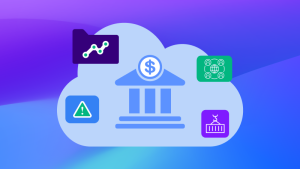Dynatrace recently hosted a webinar featuring Aurelie L’Hostis of Forrester, and here we continue the conversation as Aurelie answered four questions from Dynatrace.
Is the digital banking experience limited? You still have to rely on physical interactions for some services, alluding to the question: are banks ready for complete mobile and digital approach? Talk about moving online experience and online banking experience, but is it the same level of experience that you get within a branch to online?
The pandemic has accelerated digital adoption. Forrester data shows even the most digitally resistant customers embraced new digital behaviors during the pandemic. While some customers are eager for the return of in-person and in-branch experiences, when restrictions are lifted, many will still rely on digital channels. COVID-19 has required banks to accelerate their digital transformation and to rethink branches.
Many were already trimming their physical footprint before COVID-19. Now, low branch usage due to the pandemic, expensive leases, and real estate will bring intense cost pressure that is expected to be too much for some firms. In 2021, some banks will (mistakenly) attempt to pivot to 100% (or near-100%) digital. But while these firms may see short-term cost benefits, we expect regret will kick in later.
Banks shouldn’t abandon the branch but instead, refocus it to drive customer and employee engagement. Being smarter about their footprint and technology, as well as shifting to paperless and cashless branches, can reduce branch costs with little to no impact on the business. Most banking executives are now planning for hybrid experiences, embracing experience design to match services and channels to customer needs. Customers still value the empathy a human advisor brings, but digital technology can augment that experience. Digital should not be just about simplifying repetitive tasks; it has the power to transform the customer experience.
Is security a barrier to digitally transforming?
Security concerns impede banks’ efforts. COVID-19 is a crisis for banks but an opportunity for fraudsters and hackers. As consumers migrate online to shop, entertain themselves, and perform banking activities, they are now more at risk from account takeover, identity theft, and privacy abuses. Consumer fraud hit records amid the pandemic. In the UK alone, online fraudsters scammed consumers out of £479m in 2020. And with fraud and data breaches expected to reach an all-time high in 2021, banks are rightly worried about the security and integrity of customer interactions, which forces them to move cautiously. Some banks will face breaches and fines as a result of naïve businesses that digitized with scant regard for GDPR, PCIDSS, AML, and KYC, exposing data and compromising millions of accounts. Banks need to keep their fraud management up to date and adopt more machine-learning-based solutions to combat fraud in real-time. Therefore, whilst security isn’t a barrier to digital transformation, it is a consideration that will impact the speed at which firms transform.
Do banks have the infrastructure, resources, and expertise to make a solid digital transformation? Are these business silos slowing down the rate of change and innovation?
Technology strategies and legacy technologies are another big challenge for banks. Many banks’ digital initiatives are held back by their technology strategy and legacy technologies:
- Ancient core solutions need complex enhancements.
- A lack of skilled and knowledgeable staff causes uncertainty.
- A fear of failure prevents transformation initiatives even from starting.
Reluctant to fully transform their application landscapes, banks easily get stuck in the planning stages or focus their transformation efforts on a single functional or organizational area. Legacy application landscapes are complex, and one of the challenges of digital transformation is the need to determine the sequence and timing of application replacement and temporary changes to legacy apps. Layered architectures can help banks move away from vintage banking applications, such as traditional core banking, while mitigating transformation risk. And connected architectures can help them assemble banking application landscapes from cloud-based and on-premises applications and prepare for the heterogeneous application scenarios of the API economy.
How are traditional banks competing with the new digital era of banking i.e., Monzo?
Not to be outdone by the disruptors, many traditional banks have been investing in separate digital-only banks. But simply launching a digital bank does not guarantee success. In a crowded market, consumers need to see value and differentiation beyond the ability to bank digitally. It’s also not simply a game of partnering or competing with big tech and fintech firms.
Banking will become increasingly invisible and autonomous, as tomorrow’s customer will expect banking to be embedded at their point of need. Leading banks will build products and services as components instead of vertically integrated offerings. Products and services will be modular and composable, and banks will assemble these modular components in multiple ways to create personalized offerings on their own platform, offer products via others’ marketplaces, or insert servicing into others’ touchpoints.
As disruption continues to threaten traditional business models, banks will need to digitally transform and evolve their pricing models and revenue streams alongside this transformation. An increasing number of firms are looking to capitalize on the large number of new digital banking entrants by becoming the rails they run on. But to do so requires repackaging homegrown products or technology into services partners or third parties will value and want to pay for.
Banks will need to support multiple routes to market for their products and services, only some of which the bank will own. A bank will operate in different modes — direct to consumer, -as-a-service, marketplace seller, or platform owner — all of which may operate concurrently.
Want to hear more from our guest speaker Aurelie L’Hostis and Dynatrace’s VP of EMEA Sales, Jason Tooley? Watch our webinar on-demand here.




Looking for answers?
Start a new discussion or ask for help in our Q&A forum.
Go to forum